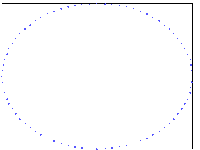 |
 |
|||||||||||||
|
|||||||||||||
|
|||||||||||||
|
The ILC is not the only accelerator that has to struggle against electron clouds and their distracting effect on the particle beam. Even the Large Hadron Collider LHC at CERN may suffer from it, and tests on two of its pre-accelerators, the PS and the SPS, have already proven several techniques with which the electron-cloud build-up can be avoided or at least be brought under better control. One of those techniques is ‘scrubbing’, and it does what it says on the packet: it scrubs the beam pipe clean from the inside. It does not do this with bucket, cloth and detergent, however. Instead, a beam at the highest possible intensity, the limit of what the machines can take, is pumped through, literally getting hoovered by the vacuum pumps.
The electron cloud problem for the LHC is not so much that it influences the beam size and structure, as it would in the ILC. The high-energy proton beams are less easily muddled up than the lighter electrons. In the LHC, the problem is heat load - if electron clouds hit beam screens in front of the superconducting magnets, they can generate heat. If this heat is too high, not all of it can be taken away by the available cooling mechanisms, and in the worst case a superconducting magnet can quench, meaning the beam is lost. It's a similar story in the warm pre-accelerators, which didn't use to have this problem when they fed beam into the LHC's predecessor LEP, but now suffer from instabilities induced by electron clouds. “We only see electron clouds when PS and SPS run with LHC beam,” says Frank Zimmermann, electron cloud expert in CERN's beams division. The high bunch charge and the distance of 25 nanoseconds between two bunches together with the typical chamber dimensions are ideal conditions for clouds to form – though obviously the experts think this is everything but ideal. The distance is just short enough for the first-generation electrons knocked out by synchrotron radiation to be pulled along in the vertical direction, hit the inner walls of the vacuum chamber and knock out more electrons, which get pulled along by the next bunch of the beam. The effect – deterioration of the vacuum, beam instabilities, generated heat – can all lead to a deterioration of the beam or a complete loss of it. The SPS does not only store proton beams for the LHC but also sends beams to fixed-target experiments on CERN's Prevessin site. "If an electron cloud builds up, these beams can interfere with each other," explains Zimmermann. This is why they have to scrub the accelerator from time to time. “Something changes in the inner surface. We don't know what it exactly is that happens - carbon seems to be accumulated -, but it works! We definitely see the electron production count go down.” Interestingly, when the accelerator is switched off for a week, the count goes up again. Scrubbing is not the only countermeasure. The beam screens protecting the superconducting magnets along the path of the beam every 300 micrometres, for example, have teeth (or grooves) that stop the photons, suppress photon reflections, and thus stop electrons getting knocked out above or below the beam. Special areas in the warmer regions of the ring (only 80 percent are at -271 degrees centigrade, the remaining 20 percent are a few degrees warmer) a special non-evaporable getter or NEG coating has been developed that, after heat activation, is very good at pumping off the residual gas and at the same time shows a low secondary emission yield. For the first few years, however, electron clouds will not be a problem for the LHC. Once the number of bunches goes up to about 3000, things will get critical - still a couple of years away, according to Zimmermann. In the planned LHC luminosity upgrade, called sLHC (for 'super LHC'), the number of bunches is supposed to stay the same as for the present LHC or even go down by a factor of two, so that the effect of electron clouds is likely to be under control. An earlier sLHC scheme which foresaw a rise in the bunch number from 3000 to 6000 with 12.5 nanosecond bunch spacing was abandoned in 2006 as the heat load predicted was deemed unacceptable. The pre-accelerators are also due for a major overhaul. A new Superconducting Proton Linac (SPL) and the PS2 successor of the PS are expected to deliver beams with a higher injection energy. “Normally higher energies mean smaller beam-induced problems,” says Zimmermann, “but because the proton beam shrinks at higher energies, the force it exerts on the electrons becomes stronger and the electron-cloud induced single-bunch instability in the SPS may become more severe at injection.” By then, the team hopes to have solved the major problems with new surface coatings and scraping techniques. Black metals or materials containing carbon have shown that they can lower the number of secondary electrons being produced by the first generation of electrons. There may also be ways to limit this first generation, which is insignificant for the LHC pre-accelerators anyway. These novel coatings are being developed for the SPS upgrade and, after successful beams tests with SPS proton beams, are now also being considered for the Compact Linear Collider Study CLIC and the ILC. Planned tests at Cornell's CesrTA will show how they behave with electron beams. A large suite of dedicated diagnostic tools is also constantly evolving, which will help accelerator physicists understand the electron cloud effect better. At the moment they worry about other things – how to get beam back into the LHC. “We'd be happy to reach the beam intensity that would start the formation of electron clouds,” says Zimmermann. He thinks that this will take around three or four years. -- Barbara Warmbein
|
|||||||||||||
| © International Linear Collider |

